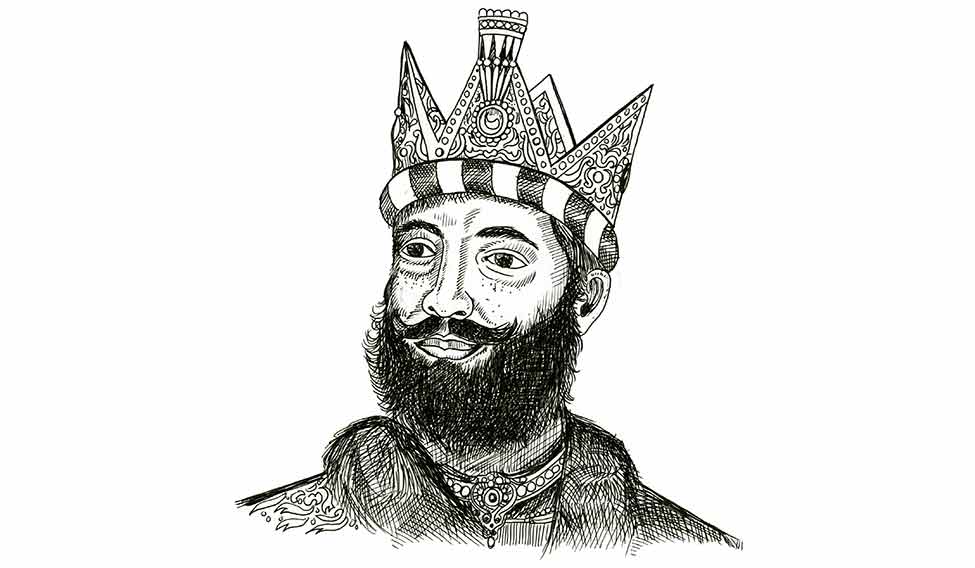
Mahmud, the governor of Ghazni, [in present-day Afghanistan] was the first Muslim ruler to penetrate deep into India. He was successful in breaking up the military strength of the Indians kings and plundering their wealth, but he did not establish an empire in India.
Mahmud belonged to the Yamini dynasty, generally known as the Ghaznavi dynasty, which claimed its origin from the family of the Persian rulers. During the course of the Arab invasion, the family fled to Turkistan and became one with the Turks. Alp Tigin founded the independent kingdom of this dynasty by snatching the kingdom of Jabul with its capital Ghazni from Amir Abu Bakr Lawik in 936 CE.
Mahmud was born on November 1, 971 CE. He received Islamic education and acquired a fair knowledge of the Quran, the hadith and principles of Islamic theology and jurisprudence. Even as a boy, he took part in a number of wars and was known for his acts of valour and efficient leadership. In 994 CE, he became the commander of the Khorasan army, but later defied the authority of the Samanid ruler and occupied Khorasan. The Caliph Qadir Billah recognised Mahmud's authority over all that he held and conferred on him the titles Yamin-ud-Daula (the right hand of the empire) and Amin-ul-Millat (protector of people).
These military and diplomatic successes made Mahmud all the more ambitious and it is said that he took an oath to invade India every year. There are various reasons attributed for this. One is that Mahmud wished to establish the glory of Islam in India. But there are scholars like Mohammad Habib who say Mahmud was not a religious zealot, but just an ordinary man whose barbarity tarnished Islam's image. Some scholars say Mahmud attacked Hindu temples for their wealth. He looted Muslim rulers in central Asia, too. However, according to Utbi, Mahmud's court historian, the attacks were part of jihad, aimed at spreading Islam and putting an end to idol worship. Historian A.B. Pandey is of the view that Mahmud attacked India for its elephants, which were to be used in campaigns against his enemies in central Asia.
According to Henry Elliot, Mahmud invaded India 17 times in 27 years. His gains in gold and jewels after defeating Jayapala and from the sack of Nagarkot, Mathura, Kannauj and Somnath were immense. Although some of the Indian rulers put up a fight, Mahmud's strength, courage, superior generalship and self-confidence made him victorious. However, on a few occasions, Mahmud’s victory had been in grave doubt, like against Baji Ray of Bhatinda in 1005 CE, against Anandpala in 1008-09 CE and against Ganda Chandela in 1019 CE, while in 1026 CE, he dare not face the forces of Bhoj at all.
Yet, it is a fact that Mahmud could get over every difficult situation by his fearlessness, self-confidence, the capacity to judge men accurately, by adjusting his tactics and strategy and by enjoying the complete confidence of his followers. Combining religious zeal and economic motivation, he fired his soldiers with such enthusiasm that they were prepared to do anything at his bidding. He had an efficient spy system, too, which helped him plan his plunders effectively. Mahmud converted his small inheritance into a mighty empire which extended from Iraq and the Caspian Sea in the west to the Ganges in the east. It was more extensive than the empire of the Khalifa of Baghdad.
Mahmud did not establish a Turkish empire in India. He was satisfied with plundering the wealth of India and with the reputation of an idol breaker. Despite his penchant for plunder, he was an educated man and a patron of arts. He took from India reputable craftsmen, who by their artistic creations won for Mahmud great reputed in contemporary Muslim world and placed central Asia under a debt of gratitude to Indian art traditions. Under him, Ghazni became not only a beautiful city of the east, but also the centre of Islamic scholarship, fine arts and culture.
Syed Mubin Zehra is a historian, social analyst and columnist.
Iltutmish
Turkish delight
Shams-ud-din Iltutmish was undoubtedly the first real Turkish sultan of Delhi. He saved the Delhi Sultanate from the Mongols, reined in Rajput chiefs, made his family rule hereditary, issued coins (the silver tanka and the copper jital) and beautified Delhi. Belonging to the Ilbari tribe of central Asia, he was purchased as a slave by Qutb-uddin-Aibak. His outstanding qualities powered his rise to military commander and, eventually, sultan. Sir Thomas Wolseley Haig calls him the “greatest of all the slave kings”
Iltutmish introduced Persian customs in his court and patronised scholars and artists, especially those fleeing the Mongols. He beautified Delhi with minarets, mosques, madrasas and tanks and ensured that the city became the political, administrative and cultural centre of the Turkish Empire in India. His nominating daughter Raziya Sultan as successor highlights the fact that he minimised the role of ulemas in state affairs. Pious and contemplative, Iltutmish respected Sufis, especially Qutbuddin Bakhtiyar Kaki, whose dargah stands near the Qutub Minar
According to Dr K.A. Nizami, the administrative setup of the Iqta (province) and the maintenance of the army of the Sultan were Iltutmish's contributions. A farsighted diplomat, he worked to save the Turkish Empire. Historian Dr R.P. Tripathi is effusive in his praise: “The history of Muslim sovereignty in India begins with him”.





